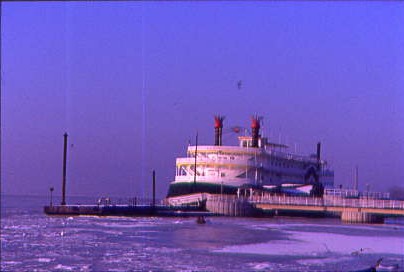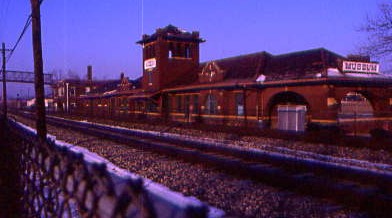After an interesting walk around Fort Madison, I prepared for dinner.
The view from my room, with old Fort Madison, a riverboat and the mighty Mississippi River behind. I went down to Alpha's On the Riverfront for dinner with the owner of the Kingsley Inn, Fayek Andrawes and James R. Noll of Fort Madison Bank & Trust.
We conversed about a future project to have a short piece of track so a doodlebug railcar could shuttle people along the river. Amtrak was planning be move into the former Santa Fe station a few short blocks away and they had plans for both a railroad museum and model railroad museum. I suggested a viewing platform be built down by the railroad/highway bridge across the Mississippi River so the public could have a safe place to photograph trains, as well as to watch river traffic.
I enjoyed a New York strip steak, which was excellent then after dinner, we went up to Fayek's residence and talked for a little more before I thanked for a very enjoyable evening and ventured out into the cool evening.
The northwest view of the Kingsley Inn.
A closer view of the north side.
The hotel sign along Avenue H, otherwise known as Business 61.
The decorated hotel from Avenue H.
A Christmas light display at Riverview Park.
Santa Fe 4-8-4 2913. I then walked through the light display.
What caught my eye first was the train.
The fountain was next.
The angel.
A hot air balloon.
Various subjects.
Cinderella's coach.
A spaceship.
Christmas wreath.
A cement truck.
Candles.
Sailboat.
Rodeo.
Steam tractor.
Statue of Liberty.
Tractor.
Ferris wheel.
Christmas ornament.
Santa Fe bridge across the Mississippi River.
A car carrying a Christmas tree.
The Eiffel Tower.
The hot air balloon with the train, just as the westbound Southwest Chief went through Fort Madison on the way to its stop in the BNSF yard. I returned to the Inn to write this part of the story before enjoying the sauna tub and calling it night.
12/19/2007 Early in the morning, I went for a walk and took some extra pictures with my 35 mm camera.


Old Fort Madison. The city of Fort Madison was established around the site of the historic Fort Madison (1808–1813), which was the first permanent United States military fortification on the Upper Mississippi. Fort Madison was the site of Black Hawk's first battle against United States troops, the only real War of 1812 battle fought west of the Mississippi. It was also the location of the first Americna military cemetery in the upper Midwest. The fort was named for James Madison, fourth President of the United States.
Fort Madison was one of three posts established by the United States Army to establish control over the newly acquired Louisiana Purchase territories. Fort Madison was built to control trade and pacify Native Americans in the Upper Mississippi River region. The other two posts were Fort Belle Fontaine near St. Louis, which controlled the mouth of the Missouri, and Fort Osage, near what is now Kansas City, which controlled trade with western Native American tribes.
A disputed 1804 treaty with the Sauk and affiliated tribes led to the United States claim of control over western Illinois and parts of what is now Iowa. To establish control, the Army set out to construct a post near the mouth of the Des Moines River, a major trading route into the interior of Iowa. Not finding suitable land near the mouth of the Des Moines, the expedition also considered land near Quashquame's Sauk and Meskwaki village at the head of the Des Moines Rapids, a choke point of trade and transportation on the Upper Mississippi below modern Montrose. Again, this land was not considered suitable for a fort. The Army settled on a location several miles upstream at what is now the city of Fort Madison.
First called Fort Belleview, this post was also soon deemed inadequate. It was poorly situated at the base of a bluff next to a deep ravine, areas from which enemies could safely fire at the fort. Its construction led to resentment among the local Native Americans, especially the Sauk: They considered the 1804 treaty invalid, the fort threatened established trading networks, and American trade goods were considered inferior to French or British goods.
Almost from the beginning, the fort was attacked by Sauk and other tribes. Troops were harassed when they left the fort and in April 1809, only threat of cannon fire stopped an attempted storming of the fort. During its existence, several improvements were made to the fort, including reinforcing the stockade and making it higher, extending the fort to a nearby bluff to provide cover from below, and constructing of additional blockhouses outside the stockade. These improvements could not fully compensate for the fort's poor location, however, and it was again attacked in March 1812, and was the focus of a coordinated siege in the following September. The September siege was intense and the fort was nearly overrun. Significant damage resulted to fort-related buildings, and the attack was only stopped when cannon fire destroyed a fortified Indian position. Black Hawk participated in the siege, and claimed to have personally shot down the fort's flag.
As the War of 1812 expanded to the frontier, British-allied Sauk and other tribes began a determined effort to push out the Americans and reclaim control of the upper Mississippi. Beginning in July 1813, attacks on troops outside the fort led to another siege. Conditions were so dangerous that the Army could not recover the bodies of soldiers killed outside the fort and troops could not leave the fort to collect firewood. The Army burned outbuildings to prevent them from falling into Indian hands. After weeks of paralyzing siege, the Army finally abandoned the post, burning it as they evacuated. They retreated in the dark through a trench to the river, where they escaped on boats. The date of the abandonment is unknown, as much of the military correspondence from this period of the war is missing, but it probably happened in September. Black Hawk observed the ruins soon after. "We started in canoes, and descended the Mississippi, until we arrived near the place where Fort Madison had stood. It had been abandoned and burned by the whites, and nothing remained but the chimneys. We were pleased to see that the white people had retired from the country."
United States government had established a federal fur trade station at Fort Madison in 1808. It was burned down in 1812 by order of the military commander who feared that it would endanger the fort. Three active battalions of the current 3rd Infantry (1–3 Inf, 2–3 Inf and 4-3 Inf) perpetuate the lineage of the old 1st Infantry Regiment, which had a detachment at Fort Madison.
Early settlers built their homes near the ruins and named the town that grew up around them for the fort. A large monument was erected in the early 20th century at the fort location. Archaeological excavations in the parking lot of the Sheaffer Pen Company factory in 1965 exposed the fort's central blockhouse and the foundations of officers' quarters. The site was listed on the National Register of Historic Places in 1973. A replica fort was built several blocks away; much of the labor was supplied by volunteer inmates at the nearby Iowa State Penitentiary.
The fort site is now the subject of preservation efforts. After the Sheaffer Pen factory closed in 2007, the site was sold to developers. Arguing that Fort Madison is "Iowa's most important historical site", preservationists want to convert the parking lot into a memorial park dedicated to soldiers killed at the fort. So far, no agreement has been reached for its preservation.

The Catfish River bend floating casino docked at Fort Madison which used to berth here from April to October and spent the rest of the year in Burlington, Iowa. It is now out of business.

The Santa Fe station, now a museum, but was planned to become the Amtrak station.
Santa Fe caboose 999235,nee Santa Fe 2194 built by the railroad in 1942.


A westbound BNSF freight passed the station.

An eastbound BNSF freight on the former Chicago, Burlington and Quincy line passing the former Chicago, Burlington and Quincy station. I returned to the Kingsley Inn then later, walked over to the Santa Fe bridge across the Mississippi River and hoped a westbound would come by. I chose a route via the Fort Madison Marina and after asking if I could take pictures from their property, walked down along the edge of the harbour.


A westbound Union Pacific train crossing the bridge.

The Mississippi River.


A few minutes later, a westbound BNSF train came across. Satisfied, I walked back to the Kingsley Inn and as I approached, heard a train horn and knew this one was on the former Chicago, Burlington and Quincy tracks, which I caught across the street from the Kingsley Inn. Back to the Emporium where I had stashed my bags, I put away the camera and walked to Alpha's for an early dinner, where I had Filet Mignon wrapped in bacon which was excellent.